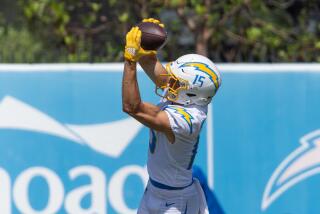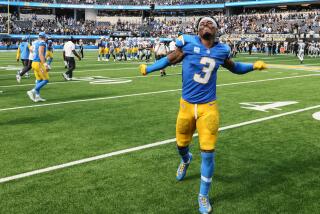Sports Pros Look, Train for ‘Retirement’ Jobs
Getting forced out after a lifetime on the job may be a terrifying prospect for most workers but for professional athletes, it comes a lot earlier.
Retirement for most sports professionals means leaving a career after years of training but at a time--generally in their late 20s or early 30s--when most people are beginning to taste career success.
With the heavy emphasis on brawn instead of brains, most athletes leave the sports fields ill-prepared for the business realities they will confront.
Increasingly, however, athletes are facing up to the inevitable: Many now invest wisely or go into business for themselves.
Others seek the training and education needed to move into another career.
In San Diego, a handful of current and former athletes have met this post-sports challenge head-on, setting up their own ventures or establishing training areas for colleagues.
“Sooner or later, when they say you can’t play anymore, reality jumps up and slaps you in your face,” said Johnny Rodgers, the 1972 Heisman Trophy winner and a former wide receiver with the San Diego Chargers.
Knee injuries forced Rodgers into retirement in 1980, plunging him into an emotional trauma psychologists call the “Three-Ds”--depression, disorientation and denial.
“It’s all right to dress up and play every Sunday. You’re a hero,” Rodgers said. “But when you go out there without that number on your back, you’re facing a war alone.”
Rodgers was lucky. His bout with the Three-Ds was relatively short.
Many retired athletes can begin collecting a pension at age 45, 55 or in some cases 65, depending on how long they have participated in which professional sport.
Rodgers joined the pros right out of college. Forced by injuries to retire just eight years later, he could have begun to collect a reduced pension, but with six sons and a daughter, he realized that the payments would not support his family, and a full pension was years away.
Within a week of his retirement, the former wide receiver decided to publish TUNED IN, a weekly cable listing and life styles magazine. Rodgers, who said he spent the first week of his retirement in front of the television set, was frustrated by the lack of cable television listings available in San Diego, the nation’s most heavily cabled city.
Backed by money from developer Tawfiq Khoury, Rodgers began TUNED IN. The first issue sold roughly 200 copies, and Rodgers gave another 200 away without charge. But as cable popularity grew, so did his subscribers, and within four months Rodgers stopped giving his magazine away.
Circulation rose steadily until the Showtime movie channel entered the San Diego market, attracting new cable subscribers and sparking a 15-fold increase in the magazine’s circulation.
Circulation peaked at 65,000 last year but has since dropped to about 50,000, primarily because area newspapers have beefed up their cable listings.
Rodgers acknowledges that his name helped his magazine get off the ground, but he insists that “advertisers pay TUNED IN’s publishing bills . . . old football memories (didn’t).”
At first, however, advertisers “didn’t trust me,” Rodgers said. “They just saw me as a dumb jock trying to make it in their world.”
Rodgers is bitter toward his coaches and college counselors, who failed to remind him that sports fame wouldn’t last forever.
“Football players are commodities, they come and they go,” Rodgers said. “Is a farmer concerned about what a cow will do once it stops producing milk?” he asked.
Rodgers, whose six sons hope to follow in his football footsteps, said he founded the Professional Athletes Community Efforts (PACE) organization to prevent his sons and others like them from falling into the same hard times footsteps so many pro athletes encounter.
PACE sponsors lectures at local San Diego high schools where Rodgers and other athletes offer career and academic counseling and warn young athletes about drug abuse.
“You spend more time on the practice fields and locker rooms than you do in the classroom. They teach you the rules to the game, but they forget to teach you the rules of life,” Rodgers said.
Other sports figures in San Diego also have made a business of helping fellow athletes.
Five years ago, San Diego Padres first baseman Steve Garvey founded a nonprofit career testing and counseling program which helps place professional athletes in executive positions after early retirement.
Dave Cash, a former second baseman with the Padres who also played for the Montreal Expos, Pittsburgh Pirates and Philadelphia Phillies, is trying to take the concept of helping fellow athletes one step further by teaching them entrepreneurial skills so they can go into business for themselves.
Cash’s Creative Systems Business Development is one of a growing number of “business incubators” in Southern California.
Cash claims the incubator concept, which is similar to a vocational business school, is well suited to retired athletes who are used to working with team members to achieve their goals. Professional athletes, Cash acknowledged, are extremely high-risk entrepreneurs because they usually lack the training or experience they need to succeed.
Cash is trying to recruit 50 members who will split into five separate groups for four months of classroom instruction. By the fifth month, the athletes will work on business and marketing projects for Cash’s privately-owned sports and health club, sports injury clinic and interstate trucking businesses.
“The idea is to turn out a group of ready-made” business people, Cash said. “Our program is like a business school, apprenticeship and placement office all in one.”
Success for Cash’s business is still ahead. So far he and his partner have only a handful of the investors they need to start the program. Cash, who currently spends most of his time recruiting for Creative Systems Business Development, expects to start the classroom training by October.
Garvey’s company is called the PACE Center for Career Development, although it is not connected to Rodgers’ PACE program. Athletes from all over the world visit the PACE Center in La Jolla, where a team of career counselors and sports psychologists help them determine their career interests and ability to successfully pursue career goals.
“Many times, when a player comes in, he is in his late 20s or 30s and has never had a day of actual work experience,” said Mike Correy, who runs Pace’s career out-placement service.
“His previous successes were based on athletic ability. Then he tries to enter the business world, where he needs a lot more than muscle to reach the top,” Correy said.
Through an extensive series of tests, PACE consultants try to determine an athlete’s competency and then, if necessary, help him secure the training he needs to reach his goals.
Mike Correy, who spent nearly 20 years recruiting senior executives for several Fortune 500 companies, now spends his time contacting companies interested in hiring retired athletes.
Correy places 70% of the athletes who participate in the PACE program. Of the remaining 30%, 10% go back to school or start their own businesses.
Because nearly 50% of all businesses fail within the first five years, Pace counselors advise retired athletes to work for other companies before starting their own.
Running a business is particularly difficult for athletes who are still playing and who must divide their time between the board room and the practice field, according to San Diego Charger offensive lineman Ed White.
Indeed, White’s responsibilities with Fairbanks Landscaping proved to be too much, and he sold his interest in the Rancho Santa Fe-based landscape architecture firm three months ago.
“We got so big so fast that I wound up doing things I really did not want, or was not trained to do,” said White, who has designed lawns and gardens in his spare time for more than 10 years. He founded his firm in 1978 with partner Greg Cranton.
“It became too much of a mental strain,” White said. “Being in business for yourself is not an eight-hour job. Top that off with nine months of training and it is enough to drive someone crazy.”
San Diego Padres utility infielder Kurt Bevacqua, who publishes Baseball Gold, a monthly baseball magazine, agreed.
“Baseball is still my life,” Bevacqua said. “Baseball Gold, on the other hand, is my future. I’ll deal with that when I get to it. “ Bevacqua’s paid staff assumes most of the burden of editing and publishing his magazine.
Others, such as Chargers quarterback Dan Fouts, take their tasks more seriously.
In July, Fouts and his older brother, Bob, opened Fouts Financial, a full-service mortgage brokerage firm. Fouts said he is aware of the risks involved in going into business but he acknowledged that “having a brother in the business doesn’t hurt.”
The idea started as a casual conversation between the two brothers after Bob Fouts had secured a construction loan for his younger brother’s Rancho Santa Fe home. Dan, impressed by his brothers services, suggested the two go into business in San Diego’s burgeoning North County.
Within a year, the two had set up shop in La Jolla.
Bob Fouts, former vice president of Financial Transaction Corp. and a former loan officer for Central Bank in Walnut Creek, plans to assume most of the responsibilities during the current football season.
But younger brother Dan, who admits that his experience in real estate has been primarily as a client and not a broker, said his familiarity with the area and contacts will contribute to the business.
“I know I can’t play football all my life. Anyone who thinks he can is crazy,” he said.
Although Fouts has accumulated many records since he started playing pro football in 1973, a string of injuries is now forcing him to consider retirement options.
The financial firm, he says, will make it much easier to leave the playing field and retire to his Rancho Santa Fe home.
More to Read
Go beyond the scoreboard
Get the latest on L.A.'s teams in the daily Sports Report newsletter.
You may occasionally receive promotional content from the Los Angeles Times.










